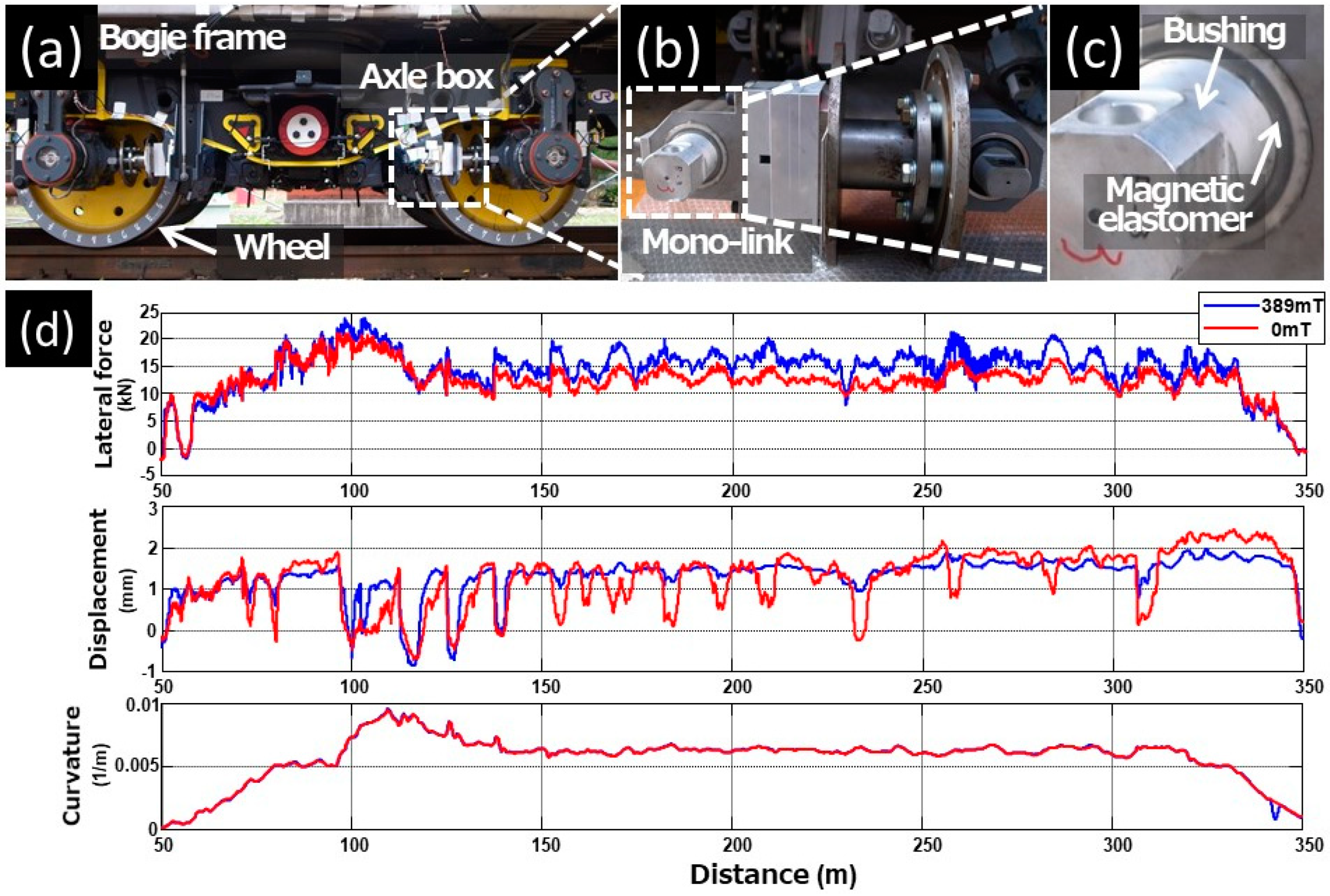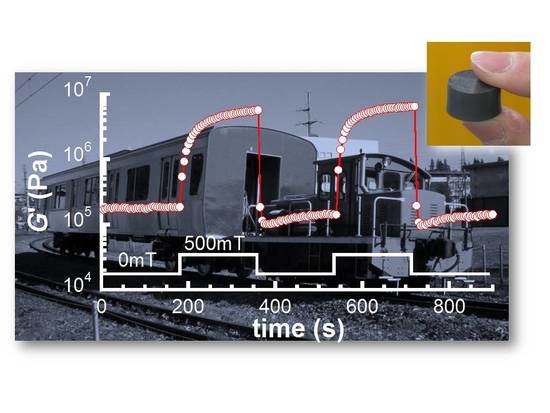Railway Actuator Made of Magnetic Elastomers and Driven by a Magnetic Field
Abstract
:1. Introduction
2. Experimental Procedures
2.1. Synthesis of Magnetic Elastomers
2.2. Dynamic Viscoelastic Measurement and Compression Test
3. Results and Discussion
3.1. Magnetic Field Response in Shear Modulus
3.2. Magnetic Field Response in Compressional Modulus
3.3. Fabrication of Actuators for Railways
4. Conclusions
Author Contributions
Funding
Acknowledgments
Conflicts of Interest
References
- Xu, Y.G.; Gong, X.L.; Xuan, S.H. Soft magnetorheological polymer gels with controllable rheological properties. Smart Mater. Struct. 2013, 22, 075029. [Google Scholar] [CrossRef]
- Gong, X.L.; Xu, Y.G.; Xuan, S.H.; Guo, C.Y.; Zong, L.H.; Jiang, W.Q. The investigation on the nonlinearity of plasticine-like magnetorheological material under oscillatory shear rheometry. J. Rheol. 2012, 56, 1375–1391. [Google Scholar]
- Xu, Y.G.; Gong, X.L.; Xuan, S.H.; Li, X.F.; Qin, L.J.; Jiang, W.Q. Creep and recovery behaviors of magnetorheological plastomer and its magnetic-dependent properties. Soft Matter 2012, 8, 8483–8492. [Google Scholar] [CrossRef]
- Sun, T.L.; Gong, X.L.; Jiang, W.Q.; Li, J.F.; Xu, Z.B.; Li, W.H. Study on the damping properties of magnetorheological elastomers based on cis-polybutadiene rubber. Polym. Test. 2008, 27, 520–526. [Google Scholar] [CrossRef]
- Chertovich, A.V.; Stepanov, G.V.; Kramarenko, E.Y.; Khokhlov, A.R. New Composite Elastomers with Giant Magnetic Response. Macromol. Mater. Eng. 2010, 295, 336–341. [Google Scholar] [CrossRef]
- Levin, M.L.; Polesskii, D.E.; Prokhorov, I.V. Some features of the magnetorheological effect. J. Eng. Phys. Thermophys. 1997, 70, 769–772. [Google Scholar] [CrossRef]
- Ulicny, J.C.; Snavely, K.S.; Golden, M.A.; Klingenberg, D.J. Enhancing magnetorheology with nonmagnetizable particles. Appl. Phys. Lett. 2010, 96, 231903. [Google Scholar] [CrossRef]
- Mitsumata, T.; Ikeda, K.; Gong, J.P.; Osada, Y.; Szabo, D.; Zrinyi, M. Magnetism and compressive modulus of magnetic fluid containing gels. J. Appl. Phys. 1999, 85, 8451–8455. [Google Scholar] [CrossRef]
- Mitsumata, T.; Abe, N. Magnetic-field sensitive gels with wide modulation of dynamic modulus. Chem. Lett. 2009, 38, 922–923. [Google Scholar] [CrossRef]
- Mitsumata, T.; Ohori, S. Magnetic polyurethane elastomers with wide range modulation of elasticity. Polym. Chem. 2011, 2, 1063–1067. [Google Scholar] [CrossRef]
- Mitsumata, T.; Honda, A.; Kanazawa, H.; Kawai, M. Magnetically tunable elasticity for magnetic hydrogels consisting of carrageenan and carbonyl iron particles. J. Phys. Chem. B 2012, 116, 12341–12348. [Google Scholar] [CrossRef] [PubMed]
- Mitsumata, T.; Ohori, S.; Honda, A.; Kawai, M. Magnetism and viscoelasticity of magnetic elastomers with wide range modulation of dynamic modulus. Soft Matter 2013, 9, 904–912. [Google Scholar] [CrossRef]
- Chiba, N.; Yamamoto, K.; Hojo, T.; Kawai, M.; Mitsumata, T. Wide-range modulation of dynamic modulus and loss tangent for magnetic elastomers containing submilimeter magnetic particles. Chem. Lett. 2013, 42, 253–254. [Google Scholar] [CrossRef]
- Nanpo, J.; Nagashima, K.; Umehara, Y.; Kawai, M.; Mitsumata, T. Magnetic-field sensitivity of storage modulus for bimodal magnetic elastomers. J. Phys. Chem. B 2016, 120, 12993–13000. [Google Scholar] [CrossRef] [PubMed]
- Haining, A.; Picken, S.J.; Mendes, E. Nonlinear rheological study of magneto responsive soft gels. Polymer 2012, 53, 4164–4170. [Google Scholar]
- Sorokin, V.V.; Belyaeva, I.A.; Shamonin, M.; Yu, E. Kramarenko. Magnetorheological response of highly filled magnetoactive elastomers from perspective of mechanical energy density: Fractal aggregates above the nanometer scale? Phys. Rev. E. 2017, 95, 062501. [Google Scholar] [CrossRef] [PubMed]
- Hentschke, R. The payne effect revisited. eXPRESS Polym. Lett. 2017, 11, 278–292. [Google Scholar] [CrossRef]
- Nagashima, K.; Kanauchi, S.; Kawai, M.; Mitsumata, T.; Tamesue, S.; Yamauchi, T. Nonmagnetic particles enhance magnetoelastic response of magnetic elastomers. J. Appl. Phys. 2015, 118, 024903. [Google Scholar] [CrossRef]
- Ohori, S.; Fujisawa, K.; Kawai, M.; Mitsumata, T. Magnetoelastic behavior of bimodal magnetic hydrogels using nonmagnetic particles. Chem. Lett. 2013, 42, 50–51. [Google Scholar] [CrossRef]
- Nagashima, K.; Nanpo, J.; Kawai, M.; Mitsumata, T. Transition from linear to nonlinear viscoelasticity for bimodal magnetic elastomers under a magnetic field. Chem. Lett. 2017, 46, 366–367. [Google Scholar] [CrossRef]
- Umehara, Y.; Kamoshita, S.; Oguro, T.; Mitsumata, T. Axle box suspensions using magnetic elastomers with variable elasticity. Trans. Jpn. Soc. Mech. Eng. 2017, 83, 847. [Google Scholar]
- Akama, S.; Ikeda, J.; Kawai, M.; Mitsumata, T. A feature in magnetorheological effect for polysaccharide magnetic hydrogels. Chem. Lett. 2018, 47, 1240–1242. [Google Scholar] [CrossRef]




| Particles | Young’s Modulus E (kPa) | Stress at 0.22 σ (kPa) | ||||
|---|---|---|---|---|---|---|
| 0 (mT) | 480 (mT) | E480/E0 | 0 (mT) | 480 (mT) | σ480/σ0 | |
| SP | 567.7 | 784.2 | 1.38 | 250.0 | 285.5 | 1.14 |
| LP | 339.0 | 712.0 | 2.10 | 334.3 | 404.3 | 1.21 |
| LP+NP | 752.7 | 1461 | 1.94 | 381.2 | 472.8 | 1.24 |
© 2018 by the authors. Licensee MDPI, Basel, Switzerland. This article is an open access article distributed under the terms and conditions of the Creative Commons Attribution (CC BY) license (http://creativecommons.org/licenses/by/4.0/).
Share and Cite
Umehara, Y.; Yamanaga, Y.; Akama, S.; Kato, S.; Kamoshita, S.; Kawai, M.; Mitsumata, T. Railway Actuator Made of Magnetic Elastomers and Driven by a Magnetic Field. Polymers 2018, 10, 1351. https://doi.org/10.3390/polym10121351
Umehara Y, Yamanaga Y, Akama S, Kato S, Kamoshita S, Kawai M, Mitsumata T. Railway Actuator Made of Magnetic Elastomers and Driven by a Magnetic Field. Polymers. 2018; 10(12):1351. https://doi.org/10.3390/polym10121351
Chicago/Turabian StyleUmehara, Yasuhiro, Yusuke Yamanaga, Shota Akama, Shunsuke Kato, Shogo Kamoshita, Mika Kawai, and Tetsu Mitsumata. 2018. "Railway Actuator Made of Magnetic Elastomers and Driven by a Magnetic Field" Polymers 10, no. 12: 1351. https://doi.org/10.3390/polym10121351
APA StyleUmehara, Y., Yamanaga, Y., Akama, S., Kato, S., Kamoshita, S., Kawai, M., & Mitsumata, T. (2018). Railway Actuator Made of Magnetic Elastomers and Driven by a Magnetic Field. Polymers, 10(12), 1351. https://doi.org/10.3390/polym10121351







